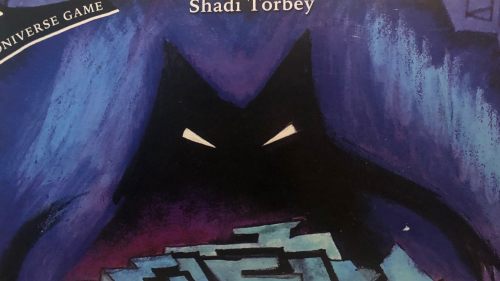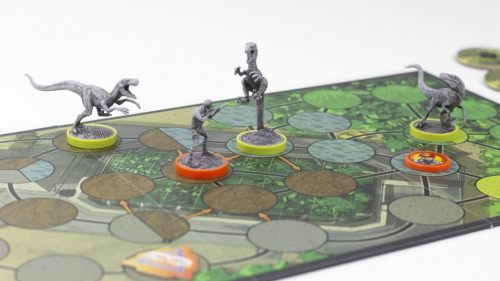Board Game Review: BIG TROUBLE IN LITTLE CHINA
I have recently come to understand (to a small amount of personal shame) that my interest in a game does in fact hinge on whether I find the concept and artwork cool. Even with flawless mechanics, I’m less likely to play a game that is both ugly and about something lame. One of those things, sure. Both? Probably not.
Which is a generous way to say licensed games perhaps unfairly win my attention. They shouldn’t. In fact, it’s more likely that an engine sits poorly with a movie arbitrarily painted all over it, or even worse, was invented willy-nilly just to sell a pretty box. Meanwhile, REAL gamers are on hour twenty of translating the all-German instruction book from some Kickstarter deck-building game where the goal is to have the greatest inventory of brass doorknobs.
Look, I’ll do that too, but my eyes are always going to trail back to games like Big Trouble in Little China. It’s not totally my fault. I love the damn movie. The box is beautiful. More importantly, it’s huge and promises a complicated game with tons of fun mini figures. Good or bad, it’s clearly not a game that was just thrown together.

The premise of the game is simple. Did you laugh because that was a joke. Not a single thing about this game is simple. Big Trouble in Little China is one you’ll need to really study before inviting pals over, lest you spend the whole night being stared at while reading the guidebook every five minutes. As indicated by its giant box, there is a ton of game in this game. It’s a fun idea to enter the world of Jack Burton and Lo Pan, but you can’t just jump in there unprepared.
It goes like this: you and your pals each pick a Big Trouble in Little China character. If you remember, there aren’t that many characters in the film, so they do a little stretching to make sure everyone has somebody to play. Each character has their own special powers, co-op abilities and special missions, helping to keep them specific and distinguished. Your crew starts at the same place on the board, but after that, can go wherever players want.
You might want to discuss those decisions before making them, however. The game is in two halves, one in the alleys and shops of Chinatown, the other a showdown within Lo Pan’s lair. How you do in the first half greatly affects what you face in the second in terms of both leveling up your character and succeeding at missions, two things you absolutely need to do if you’re going to succeed.
Missions are long, multi-part tasks that tell a story read out loud to other players. You might fight some goons, do a skill roll or try to roll specific icons to pass each part. When you win one, you get a special, powerful weapon. Believe me, you want these weapons.
There are also always three side missions on the board with their own assortment of rewards. Meanwhile, you can just run around collecting items and killing various goons if you like. It’s really up to you how you play the game, but if you don’t do some serious leveling-up you’re going to regret it later, and missions are definitely the best way to do that.
Missions also take a long time, something that is very much against you in this game. Along with adding more villains to the board and introducing actions that must be immediately resolved, each new round advances a time marker counting down to the Lo Pan half of the game. That time goes by quickly, some might say too quickly.
See, the Chinatown portion of the game is a lot of fun. It’s cool to grow these characters, and the narratives of their missions are interesting. I love teaming up with others and doing street fights or working together to resolve a mission in half the time. The game offers this sandbox filled with things to do, but then limits your time so you barely get to do any of it. I’m exaggerating slightly, but that is what it feels like. I’m always flipping the board to the other side far before I’m ready to, not just in terms of character preparation but just the flow of the game. Just as you’re getting into the groove, the section ends.
Granted, the second half is fun as well. Lo Pan’s lair has three levels, each with one of the film’s “Storm” bosses and of course Lo Pan himself. It’s very tough going, but if you’re leveled up enough, you and your friends stand a fighting chance. Nevertheless, the fun potential enjoyed in the first half is no longer present.
Some people don’t like a lot of dice in their games. Big Trouble in Little China will not be a fun game for them. There are so many dice. You have to roll one set just to allocate how many of your turn’s actions are boosted. Those actions require their own particular dice. And there are black dice that offer special powers in a pinch but can also take a heavy toll. The system is interesting, and I do like it. But that doesn’t mean it’s not overly complicated and cumbersome. You will be rolling dice all over the place, and a run of bad dice luck will absolutely limit the game's fun.

Like Evil Dead, Big Trouble in Little China’s tone is a lot more specific and harder to approximate than people might think. As such, I never feel side-products based on the film sound quite right. That’s no different here, but there is such a heavy amount of flavor text, you kind of just learn to go with this version of John Carpenter’s setting. It never feels like you’re playing the movie, though. On the other hand, all the mini figures are undeniably cool.
If you’re up for the undertaking, Big Trouble in Little China will give you a lot to chew on. I don’t think it’s a slam dunk, and only for a very curious party would I set it up on game night. There are just too many other games that are much more rewarding. But it’s always going to be there on my shelf, waiting for someone who also cannot resist that movie board game call.



